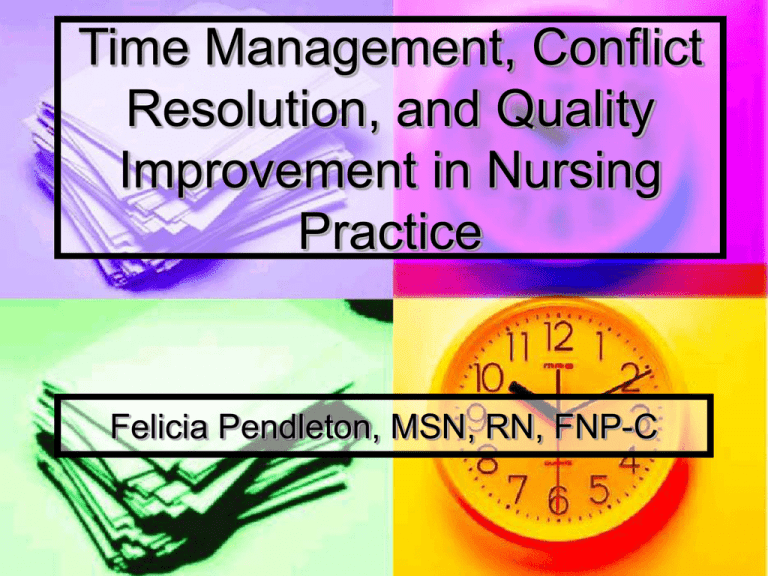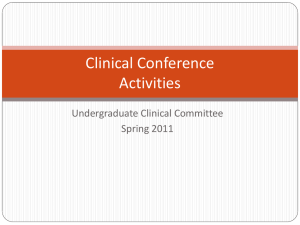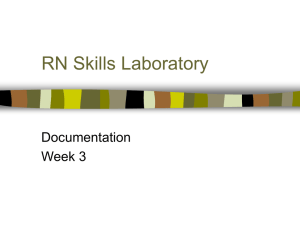Time Management, Conflict Resolution, and Quality Improvement in
advertisement

Time Management, Conflict Resolution, and Quality Improvement in Nursing Practice Felicia Pendleton, MSN, RN, FNP-C Learning Outcomes At the completion of this learning module, the student will: 1. 2. 3. 4. 5. 6. Discuss time management strategies. Discuss the relationship of conflict to management of nursing care. Discuss five conflict resolution methods. Describe the stages and phases of planned change. Identify principles and strategies in initiating change. Describe the essential activities of a quality improvement program. Issues in Nursing Practice Professional Nursing Practice: Client and Client Care Safe Practice Involves: Critical Thinking Time Management Conflict Resolution Quality Improvement Demands of Nursing Practice The current status of healthcare organizations, trying to do more with less, has led to demands (stressors) being placed on care providers and care managers Stress and Time Management Stress – decreases productivity leads to poor use of time Time Management – method to reduce stress preventive action to reduce elements of stress in nurse’s life Time Management The ability to spend your time on the things that matter to you and your organization Time Management Strategies Goal Setting Setting Priorities Organization Time Tools Managing Information Relationship of Conflict to Management of Nursing Care Stressors in the Healthcare environment: *Increased demands *Limited and aging workforce *Decrease in resources *Increased acuity *Increased underinsured client population Management of nursing care: *Stressors affect staff members and contribute to conflict in the workplace *Nurse managers must learn to deal with conflict and try to resolve it effectively Conflict Resolution Conflict Resolution Methods Avoiding Accommodating Competing Compromising Collaborating Stages and Phases of Change Linear Change: Planned Change Theories Havelock’s (1973) six-stage model, Lippit, Watson, and Westley’s (1958) sevenphases model, and Roger’s (1995) five-stage - Innovation-Decision Process Nonlinear Change: Chaos Theory Change Barriers – factors that hinder the change process Facilitators – factors that expedite the change process Effective Change Force of facilitators outweigh force of barriers Reduce barriers and support or enhance facilitators Stages of Planned Change Unfreezing Experiencing the Change Refreezing Six Stages of Planned Change (Havelock, 1973) Building a relationship Diagnosing the problem Acquiring relevant resources Choosing the solution Gaining acceptance Stabilizing the innovation and generating self-renewal Seven Phases of Planned Change (Lippitt, Watson, & Westley, 1958) Client system becomes aware of the change Relationship is developed between client system and change agent Change problem is identified Change goals are set and options for achievement are explored Plan for change is implemented Change is accepted and stabilized Change entities redefine their relationships Innovation-Decision Process – Five Stages (Rogers, 1995) Knowledge Persuasion Decision Implementation Confirmation Effective Management Practices for Instituting Change Managing change process actively Balancing tension between efficiency and reliability Creating a learning environment Creating and sustaining trust Involving the staff in decision-making Principles and Strategies in Initiating Change Change Management: Five Functions Planning (includes assessment) Organizing Implementing Evaluating Seeking feedback Quality Improvement (QI) Goal – improve quality Focus – prevention of errors Major Tasks – Review nursing activities Innovation Staff development Quality Team – multidisciplinary Outcomes – set with input from staff and patients Essential Activities of QI Major steps in QI process: Identify needs Assemble a multidisciplinary team Collect data Establish measurable outcomes Select and implement plan to meet outcomes Evaluate plan and outcomes Reference Yoder-Wise, P.S. (2007). Leading and managing in nursing (4th ed.). Philadelphia, PA: Mosby Elsevier.











